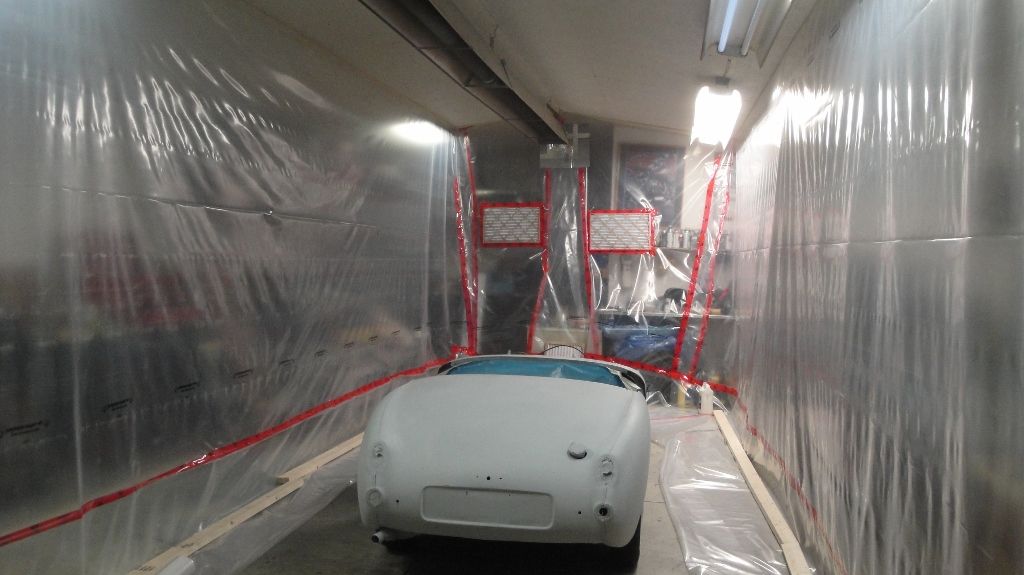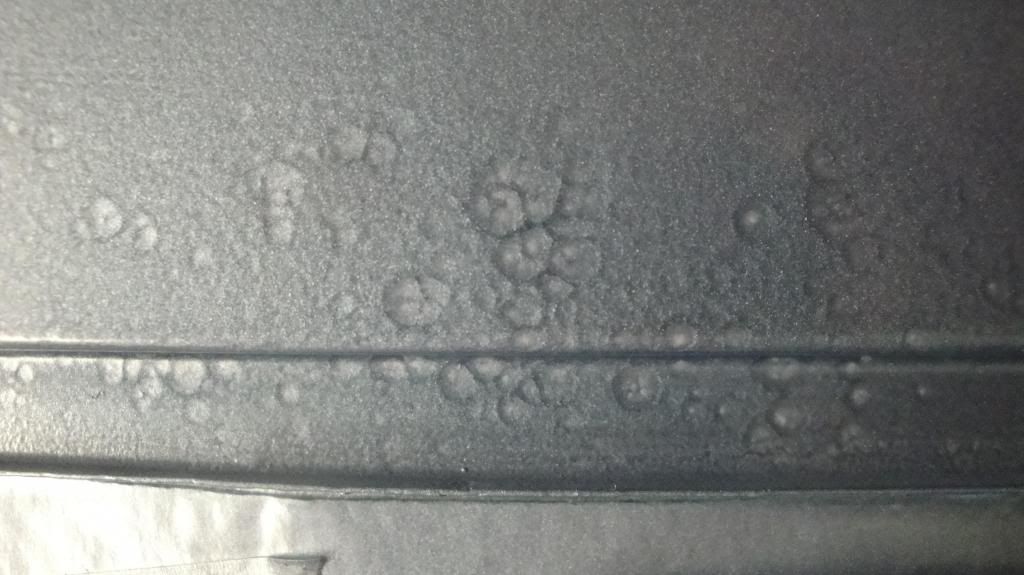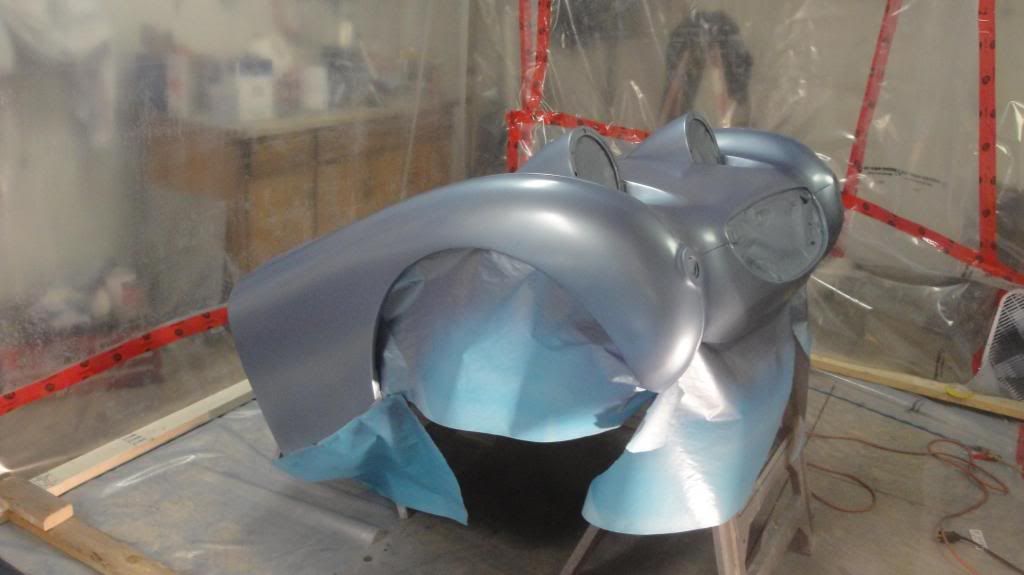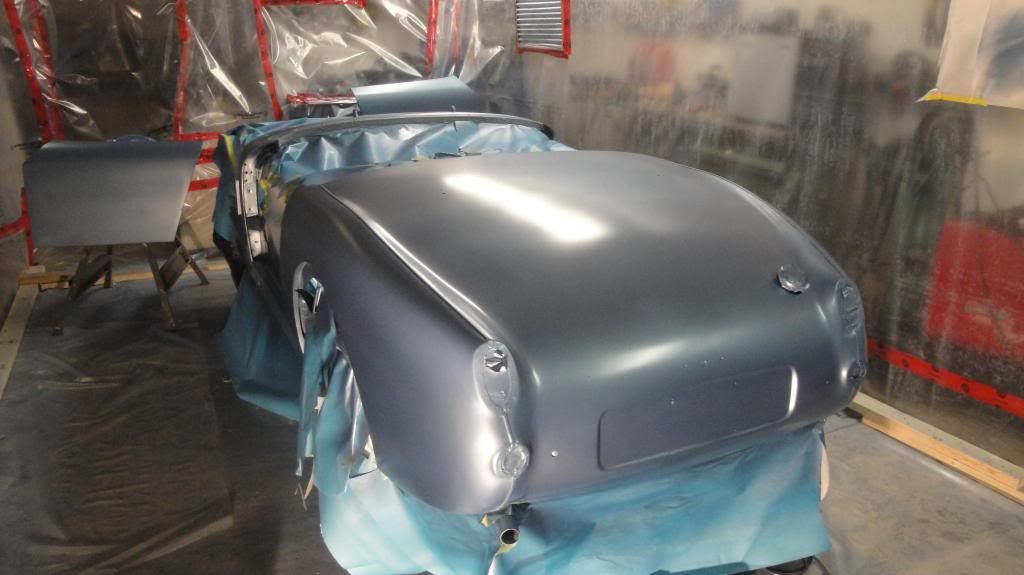 Assuming this does not go all pie shapped, this should be fun.
Assuming this does not go all pie shapped, this should be fun.
Cool -- have you done it before? Do you have time to block and sand it multiple times between coats? And, what colour?
ZOO wrote: Cool -- have you done it before? Do you have time to block and sand it multiple times between coats? And, what colour?
Nope, have not done this before. Should be a blue Bugeye by nightfall.
Car has been block sanded to death over the last month. I used a new product callled "Featherfill" to do the blocksanding. Along with an assortment of Durablock sanding pads, this baby is smooth and flat.
Spent 3 hours with a leaf blower cleaning the garage before I put up the spray booth. If nothing else good comes of this, I can honestly say that my shop has never been this clean.![]()
Don't forget to wash down your floor and spray it down with water before you paint. Also, put the car at a good working height too. Your results will show it.
NOHOME wrote:ZOO wrote: Cool -- have you done it before? Do you have time to block and sand it multiple times between coats? And, what colour?Spent 3 hours with a leaf blower cleaning the garage before I put up the spray booth. If nothing else good comes of this, I can honestly say that my shop has never been this clean.
3 hours with a leaf blower?? Bet your neighbors love you....
mad_machine wrote: ok.. inquiring minds want to know... how does it look?
Well, if we don't have any updates within the next 24 hours, we can jump to either one of two coclusions...
A). The paint did not turn-out well... Or...
2). Not enough ventilation in the "booth".
I am hoping for neither, hoping to see a nice Bug-eyed Smurf in the next few hours.![]()
mad_machine wrote: ok.. inquiring minds want to know... how does it look?
Sadly, all did not go well. In places the paint reacted with something or something is coming down the air line.
Going to have to consider the two layers of basecoat as expensive guidecoat.
Featherfill been around a long time, couldn't find it for a while (when I needed it) but glad it's still available.
Sorry to hear that. You do have a water separator and a filter in the line feeding the spray gun, I assume?
Car painting seems to be a mixture of luck, skill, preparation, voodoo, timing, planetary alignment, proper materials, knowledge and equipment. Not for the faint of heart or those with little time and elbow grease.
With regards to the wet floor - I find that's mostly useful in a base/clear combo before you shoot the clear. If you're shooting single stage, you don't get the same dust on the floor causing problems.
Too much cleaner/degreaser on the body can cause problems, as can air/oil in the line. Take some pics, you can identify a lot of problems by looking at them.
I was hoping for some great after pics...............I want to try that one day but have always been a little scared. Your experience has not helped me.


 At first glance, looks pretty good. Only issue is a few too many spots like the dimpled area on the cowl. Need to come to a landing on why it would do this. Then sand it all down with 600 grit and reshoot.
At first glance, looks pretty good. Only issue is a few too many spots like the dimpled area on the cowl. Need to come to a landing on why it would do this. Then sand it all down with 600 grit and reshoot.
At this point it is just the base coat. That is why it looks flat.
trouble shooting refinish problems
Looks legit...
Did you use wax and grease remover on the surface before painting? Is either oil on the surface our oil/water in your air supply.
Those look like fisheyes to me, and they're probably from oil or silicone. Like moparman said, lots of grease/wax remover (I use PPG DX330--apply with paper towels, wipe dry with paper towels) is the first step. I also generally use a fisheye preventer like PPG DX 73 (they call it "Fisheye Eliminator") as well.
Another consideration could be your furnace. I've had friends that used kerosene and it gets enough oil residue in the air to mess up paint (not to mention other scary things from the kero fumes).
--Carl
Carl Heideman wrote: Those look like fisheyes to me, and they're probably from oil or silicone. Like moparman said, lots of grease/wax remover (I use PPG DX330--apply with paper towels, wipe dry with paper towels) is the first step. I also generally use a fisheye preventer like PPG DX 73 (they call it "Fisheye Eliminator") as well. Another consideration could be your furnace. I've had friends that used kerosene and it gets enough oil residue in the air to mess up paint (not to mention other scary things from the kero fumes). --Carl
Carl:
Thanks for chiming in on this one. I am aware of your credentials with this stuff.
The light that is slowly coming on is that using the gun wash/lacquer thinner to wipe down the panels before paint might not have been such a great idea. Seems that lacquer thinner might have components that appear oil-like to paint.
Other than some time and $$$ I guess this is not the end of the world. This weekend I will scuff the surface with 600 grit wet paper and then shoot another coat or two on top. Assuming that goes well, I will shoot the clear.
I trust, but will need to confirm, that I can shoot right on top of the exiting paint after a few days of curing.
Yea, if you washed down with lacquer thinner, that may have contributed to your problem. I think you'd be wise to check with the paint manufacturer about curing/respraying as you mention.
I've had some pretty frustrating experiences with fisheyes before, mainly on fiberglass from motorcycles or race cars where oil was more or less impregnated into the surface. Sometimes, it took multiple sandings/resprays to get it to stop, no matter how clean I thought I had it. So, what I'd advise is that, after sanding the bad areas, spot paint them and wait long enough to make sure you've solved the problem. I'd hate to see you respray the whole car and have the same problem again, given the price of paint these days. Also, depending on what paint you're using, you may be able to just spot-repair those areas, then clear the whole car. Again, check with the paint manufacturer about that.
--Carl
You'll need to log in to post.